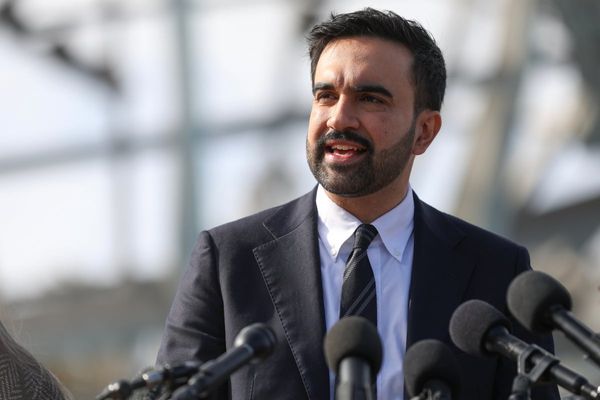
Nissan is struggling. We're not just talking financially, but also in figuring out how to plan for the future.
The automaker that bought the world one of the first commercial electric vehicles, the Nissan Leaf, has been slow to catch up to the rest of the space with more modern ones. Amid its cash crunch, it's even opted to cancel a pair of electric sedans because it didn't feel that a market existed for them. But now, right as Nissan starts to get back into the EV game, the rules in the United States are changing, and that means even more electric delays.
Welcome back to Critical Materials, your daily roundup for all things electric and tech in the automotive space. In today's edition, Nissan hits the brakes on its EV plans (again) as it delays the production of a pair of electric crossovers by almost a year. Plus, Tesla's roadblock in China isn't just CEO Elon Musk, and Kia says it's looking into building a sub-$30,000 electric city car. Let's jump in.
30%: Nissan Hits Snooze On Its EV Plans (Again)

Rather than stick to its plans of cranking out a pair of electrified crossovers for its Nissan and Infiniti brands, the Japanese automaker will kick the can down the road (yet again), this time by nearly a year.
The news comes as Trump's so-called Big Beautiful Bill puts a deadline on the EV tax credit—something which the current administration views as part of an "EV mandate" that it's so determined to kill. As such, Nissan is playing it safe as the demand for EVs in the U.S. becomes less clear.
Here's Automotive News with the scoop:
A Nissan-branded crossover, codenamed PZ1K, now will begin production in November 2028, while a related vehicle for the Infiniti brand, codenamed PZ1J, is scheduled to begin in March 2029.
In the memo, Nissan pinned the delay on “recent slowing EV demand in the U.S.”
“We’ve made the strategic decision to slightly adjust the production timeline for our EVs at the Canton plant,” Nissan spokesman Kyle Bazemore said in a statement to Automotive News. “Our goal is to ensure that this facility continues to bring highly competitive vehicles to market that exceed customer expectations.”
This particular delay is believed to be for that snazzy Xterra-Inspired adventure EV teased by Nissan back in March. It is said the be built on a new architecture that will be shared between U.S.-built crossovers, sedans (whichever Nissan decides to keep around, that is) and potentially even a small, lightweight pickup truck.
Via a memo, Nissan pins this delay on "slowing EV demand" in the States. Unofficially, it's the latest fallout from the elimination of the EV tax credit. That $7,500 boost that greased the wheels of EV adoption is on its way out, and apparently so is whatever urgency Nissan had to bring another new electric, well, anything, to market in the U.S.
It's not all for nothing. An all-new Nissan Leaf, now in compact crossover form, is coming soon. It may even carry a similarly affordable price tag. But its rollout could be more tepid than expected.
It is a shame to see an electric pioneer like Nissan struggle to catch up now. Instead of keeping the first Leaf's momentum going, it stagnated and became complacent. Its image transformed from one that sold trusted economy cars to a bargain basement brand—one that prioritized subprime 84-month loans instead of innovation.
Maybe that's the reason that Nissan has found itself at the center of a death spiral over the past year with seemingly no way out. Or, perhaps this is a way for the brand to get away with moving the marker towards hybrids and avoiding all of that costly next-gen battery-electric R&D.
Either way, it feels like a cautious corporate reshuffle aligned with the elimination of the EV tax credit, and how that will play out for Nissan remains to be seen.
60%: Tesla's Problem In China Isn't Politics—Its Cars Just Aren't Cool Anymore

Tesla's relevancy in China is dwindling like a weakened flame. China's hyper-competitive EV world has placed Tesla on the back burner as cars with tons of in-car luxury and AI features become the new kings of the auto world.
According to a new report from the Wall Street Journal, Tesla's leadership seems to be plugging its ears as employees scream for more updated cars and not ones where facelifts could have just been an email.
Here's what the WSJ has to say:
Chinese consumers say Teslas increasingly feel tired and out of touch with local tastes. Top China-designed EVs nowadays come with features that aren’t normally found in Teslas, such as multiple big screens to watch films and play games, refrigerators to keep drinks cold and in-car cameras for selfies. BYD, which makes both EVs and batteries; and battery giant Contemporary Amperex Technology, or CATL, recently said they each had developed new technologies that allow users to charge cars in just five minutes.
Tesla’s China staff have voiced concerns to headquarters about the company’s aging products, but their warnings often drew sluggish responses, China-based employees said. The frustrations have built as Chinese salespeople feel more pressure to hit targets, without the sexiest cars to sell.
Many Chinese consumers still appreciate Tesla’s brand image as an EV pioneer. And the company retains support in Beijing. Chinese leaders see Tesla as a poster child of successful foreign investment and a useful ally in helping China build a green economy, centered on industries such as renewable energy, EVs and batteries.
What's really going on behind the curtain is that domestic brands—think BYD and Xiaomi, for starters—are quickly becoming affordable cars packed with tons of tech. We've talked about this ad nauseum at this point, but even the most American of brands are realizing that China really has this EV thing down.
While Tesla has focused on minimalism and cost-savings through software, China's domestic brands have instead begun stuffing as much tech into their cars as possible. This oscillating rear vents, infotainment screens with built-in person-to-person translation, screen mirroring from your phone to your car and so many integrations that it'll make your head spin. There's a reason why Tesla's market share has fallen from 11% at its peak in 2021 to just 4% in May 2025. Even newcomer Xiaomi is tailing Tesla at 3% and global powerhouse BYD has 29% of the EV and plug-in market.
Tesla's staff in China have been raising red flags to its American counterparts. According to the WSJ, they've asked for vehicle updates and localized features, or at least some app integrations. You know, a car that actually feels like it belongs in China's ruthless car market.
The response from Austin was sluggish, and rather than feel supported, the sales teams in China have felt nothing but pressure to hit higher sales targets, all without attractive cars to sell.
If the brand can't evolve, it's going to be left behind. Maybe that means focusing more on its cars than its AI and robots, or perhaps putting someone in charge who actually wants to keep Tesla functioning as an automaker.
90%: Kia's Next Homework Assignment Is An Uber-Cheap City Car

Automakers to love to slap the world "affordable" on things. Whether it be a $55,000 EV or a car note above $1,000 per month, affordable is a very relative term. Back in the day, Tesla defined affordable as a $35,000 Model 3 (which took years to actually materialize)—now, automakers are looking to find the floor with EV pricing, wherever that may be.
Kia's CEO Ho Sung Song confirmed to AutoCar that it is doing exactly that with its city car platform. In fact, the automaker revealed that its latest homework assignment is creating a sub-$30,000 EV for putting around town.
That's expected to be potentially called the Kia EV1, smaller and cheaper than even the upcoming Kia EV2. Here's AutoCar with more:
Kia president and CEO Ho Sung Song confirmed his commitment to entry-level models and keeping his cars affordable and accessible, and to that end suggested a baby Kia is deep into its development.
Song said Kia was in no rush to replace the current Picanto city car, which is still selling well in Europe, and the strength of Kia’s electric car range means the firm isn’t under any imminent pressure from the CO2 regulations that have doomed other city cars on the market in recent years.
The Picanto, heavily updated in 2023, would therefore remain on sale up until the point that Kia was able to create an entry-level electric city car for less than €25,000. The brand feels it is important to keep such an affordable entry-level model in its range.
Song said the mooted entry-level EV was “homework” for Kia at the moment, and a sub-€25,000 model was “one area we are studying and developing”.
Let's get this out of the way first—this definitely isn't something that we expect to see here in the U.S. In case you didn't catch it, the CEO is specifically talking about a replacement for the Kia Picanto, a city car that it sells outside of the States for between $22,000 and $27,000.
That means that $30,000 is still an increase for the Picanto's segment, but it's right on-par with the average 12% uptick when comparing ICE with comparable EVs.
Where this car is sold isn't the takeaway, though. This is about Kia's next foray into electrification. See, Kia is working to right-size its EV strategy. Its early lineup (think: EV6 and EV9) was all about being flashy. Now Kia is honing in on building value-based models with more reasonable prices, and that starts in price-sensitive markets like Europe, India, and South America.
This approach to EVs is refreshingly grounded, with the focus being on what automakers can bring to the value segment. With battery prices falling and EV tech maturing—plus, let's not forget about Software-Defined Vehicles running down vehicle costs—it's only a matter of time before EVs reach true cost-parity. And once we start seeing these sub-$30,000 models like Kia is envisioning, it opens EVs up to a plethora of new car buyers.
Now we just have to see where Kia goes with this. Will it copy Tesla's homework and use an existing platform to lower costs, or is the real secret sauce something that the Koreans are working hard to hide while they cook it up? Only time will tell.
100%: Does America's EV Industry Still Need The Tax Credit?

I had my next EV all planned out and the pricing all placed in my window-shopped budget. But now, with the stroke of a pen, that EV has become $7,500 more expensive before it was even released.
Many Americans are in the same boat. They'll reluctantly shell out more cash for the vehicle that they want, even if it means a higher monthly payment. Unfortunately, there are also many who can't, and that budget constraint now means that a new EV is now unobtainium for them. Eventually, as EVs and ICE cars reach cost parity, that will become a moot point—but it's going to take a while to get there. The EV industry needs to not only survive, but thrive between now and that point.
So here's where I ask you: is the EV industry at a point now where it can survive that transition? Let me know your thoughts in the comments.







